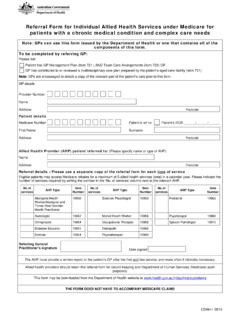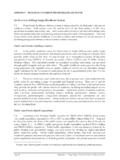Transcription of Introduction to School Health Programs
1 1 VIRGINIA School Health GUIDELINES CHAPTER 1 Introduction to School Health Programs This chapter presents overview information about establishing or enhancing School Health Programs . It also provides some background information on the evolution of School Health Programs in Virginia. In addition, it provides guidelines on program development. In This Chapter Describing the Components of a School Health Program Three-Component Model Eight-Component Model Full-Service Schools Model Terminology: Comprehensive Versus Coordinated Reviewing History: Legislative Studies The Health Needs of School -Age Children A Study on Ways to Encourage Local School Divisions to Recognize the Importance of School Nurses and the Feasibility of Establishing Standards for School Health Services Current Health Programs in the Public Schools of Virginia and the Efficacy and Appropriateness of Adopting a Comprehensive Approach to Health Education Report on the Needs of Medically Fragile Students Findings and Recommendations of the Blue Ribbon Commission on School Health Developing a Program.
2 Infrastructure and Planning Process Steps Infrastructure Planning Process Steps Establishing Roles of Personnel: Position Descriptions School Nurse: Registered Nurse School Nurse: Licensed Practical Nurse School Nurse Practitioner School Health Supervisor/Coordinator: Registered Nurse Unlicensed Assistive Personnel School Health Volunteer School Health Physician Delineating Roles and Responsibilities for the Safe Delivery of Specialized Health Care 2 2 Describing the Components of a School Health Program Overview Definition. There are a variety of definitions of a School Health program. The following definition of a comprehensive School Health program was established by the Institute of Medicine (IOM) Committee on Comprehensive School Health Programs in Grades K-12. 1 A comprehensive School Health program is an integrated set of planned, sequential, School -affiliated strategies, activities, and services designed to promote the optimal physical, emotional, social, and educational development of students.
3 The program involves and is supportive of families and is determined by the local community, based on community needs, resources, standards, and requirements. It is coordinated by multidisciplinary team and is accountable to the community for program quality and effectiveness. 2 Models. There are a variety of models that have been used to describe the components of a School Health program. Three of the most common models are summarized below. 3 The Three-Component Model. Originating in the early 1900s and evolving through the 1980s, the three-component model is considered the traditional model of a School Health program, consisting of the following basic components: (1) Health education, (2) Health services, and (3) a healthful environment. The Eight-Component Model. In the 1980s, the three-component model was expanded into an eight-component model traditionally referred to as a comprehensive School Health program consisting of the following components: (1) Health education; (2) Health services; (3) healthy School 1 The Committee on School Health in Grades K-12 was convened by the Institute of Medicine in late 1994 to carry out a study of comprehensive School Health Programs in grades K-12 to examine the structure, function, and potential of these Programs .
4 The study findings, conclusions, and recommendations are published in Allensworth, D., Lawson, E., Nicholson, L., and Wyche. J., (1997), School & Health : Our Nation s Investment, National Academy Press, Washington, 2 Allensworth, D., Lawson, E., Nicholson, L., and Wyche. J. (Eds.). (1997). School & Health : Our Nation s Investment (p. 2). Washington, : National Academy Press. 3 Allensworth, School & Health , (pp. 3, 59). 3 VIRGINIA School Health GUIDELINES environment; (4) physical education; (5) nutrition services; (6) Health promotion for School staff; (7) counseling, psychological, and social services; and (8) parent and community involvement. Full-Service Schools. In recent years, additional models, definitions, and descriptions have emerged that build on previous models, including the full-service School model.
5 In addition to quality education, a full-service School model involves a one-stop, seamless institution, where the School is the center for providing a wide range of Health , mental Health , social, and/or family services. While the most frequently encountered models and definitions of School Health Programs have much in common, no single model is best. A School Health program should be locally tailored with involvement of all critical stakeholders to meet each community s needs, resources, perspectives, and standards. Recommendation Essential Elements. While there is no one universally accepted definition and model of a School Health program, the following essential elements should be considered in designing a School Health program. 4 Services, which include Health services (which depend on the needs and preference of the community and include services for students with disabilities and special Health care needs and the traditional first aid, medication administration, and screening services), counseling, psychological, and social services (which promote academic success and address the emotional and mental Health needs of students), and nutrition and food services (which provide nutritious meals, nutrition education, and a nutrition-promoting School environment).
6 Education, which includes Health education (which addresses the physical, mental, emotional, and social dimensions of Health ), physical education (which teaches the knowledge and skills necessary for lifelong physical fitness), and other curricular areas (which promote healthful behavior and an awareness of Health issues as part of their core instruction). School Environment, which includes the physical environment (involving proper building design, lighting, ventilation, safety, cleanliness, freedom from environmental hazards that foster infection and handicaps, safe transportation policies, and having emergency plans in place), the policy and administrative 4 Allensworth, D., Lawson, L., Nicholson, L., and Wyche. J. (Eds.). (1997). School & Health : Our Nation s Investment (p.)
7 2-3). Washington, : National Academy Press. 4 4environment (consisting of policies to promote Health and reduce stress, and regulations ensuring an environment free from tobacco, drugs, weapons, and violence), the psychosocial environment (including a supportive and nurturing atmosphere, a cooperative academic setting, respect for individual differences, and involvement of families), and Health promotion for staff (in order that staff members can become positive role models and increase their commitment to student Health ). Community Participation, which includes parent and community involvement (which consists of involving a wide range of community stakeholders parents, students, educators, Health and social service personnel, insurers, and business and political leaders to develop and form the structure of the School Health program tailored to meet each local community s needs, resources, perspectives, and standards).
8 Although the schools are accountable to the community and provide a critical facility within which many agencies can work together to maintain the well-being of students, they cannot be expected to address the student s serious Health and social problems in the School setting without assistance from the community. Families, healthcare workers, the media, religious organizations, community organizations that serve children and adolescents, and young people themselves must also be involved. Subsections The following subsections describe key features of the three- and eight-component models for a School Health program and the full-service schools model: Three-Component Model Eight-Component Model Full-Service Schools Model 5 VIRGINIA School Health GUIDELINES The Three-Component Model Traditional Model. Originating in the early 1900s and evolving through the 1980s, the three-component model is considered to be the traditional model of a School Health program.
9 According to this model, a School Health program consists of the following three basic components. 5 1. Health Instruction 2. Health Services 3. Healthful School Environment Definitions. The definitions of each component of the traditional School Health program model are presented below. Key Features of a Traditional School Health Program Component Definition Health Instruction Accomplished through a comprehensive Health education curriculum that focuses on increasing student understanding of Health principles and modifying Health -related risk behaviors. Health Services Focuses on prevention and early identification and redemption of student Health problems. Healthful School Environment Concerned with the physical and psychosocial setting and such issues as safety, nutrition, food services, and a positive learning atmosphere 5 Allensworth, D.
10 , Lawson, E., Nicholson, L., and Wyche. J. (Eds.). (1997). School & Health : Our Nation s Investment (p. 52). Washington, : National Academy Press. 6 6 The Eight-Component Model CDC Model. The Centers for Disease Control and Prevention (CDC) eight-component model of a comprehensive School Health program consists of the following interactive components. 6 1. Health Education 2. Physical Education 3. Health Services 4. Nutrition Services 5. Health Promotion for Staff 6. Counseling, Psychological, and Social Services 7. Healthful School Environment 8. Parent and Community Involvement The following is a summary of CDC s definitions and descriptions of each component of a comprehensive School Health program. Key Features of a Comprehensive School Health Program Component/Definition Description Health Education A planned, sequential, K-12 curriculum that addresses the physical, mental, emotional, and social dimensions of Health .














